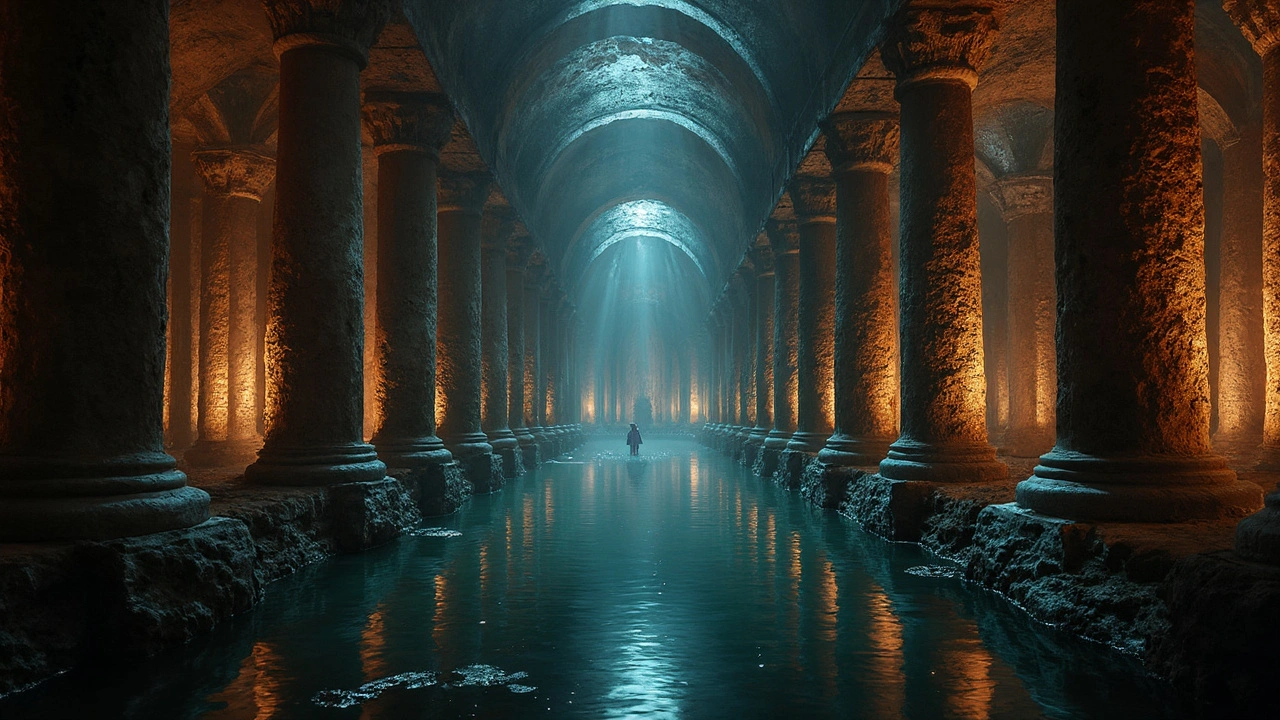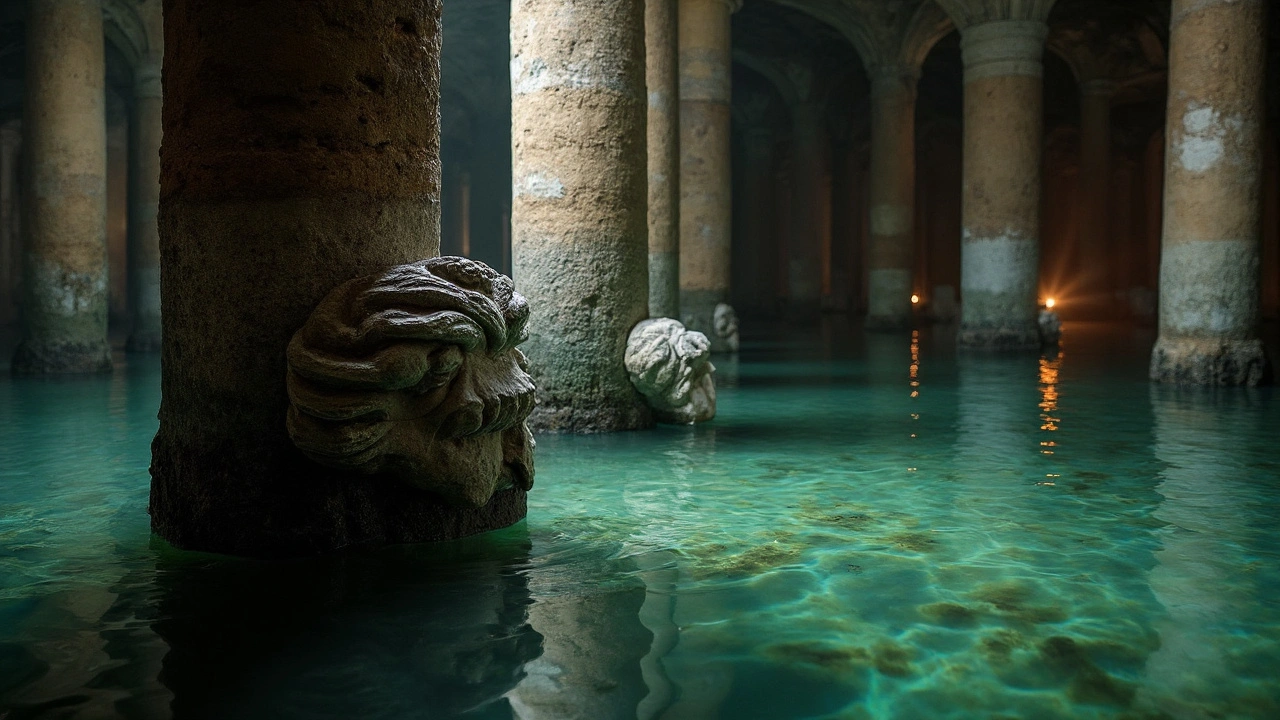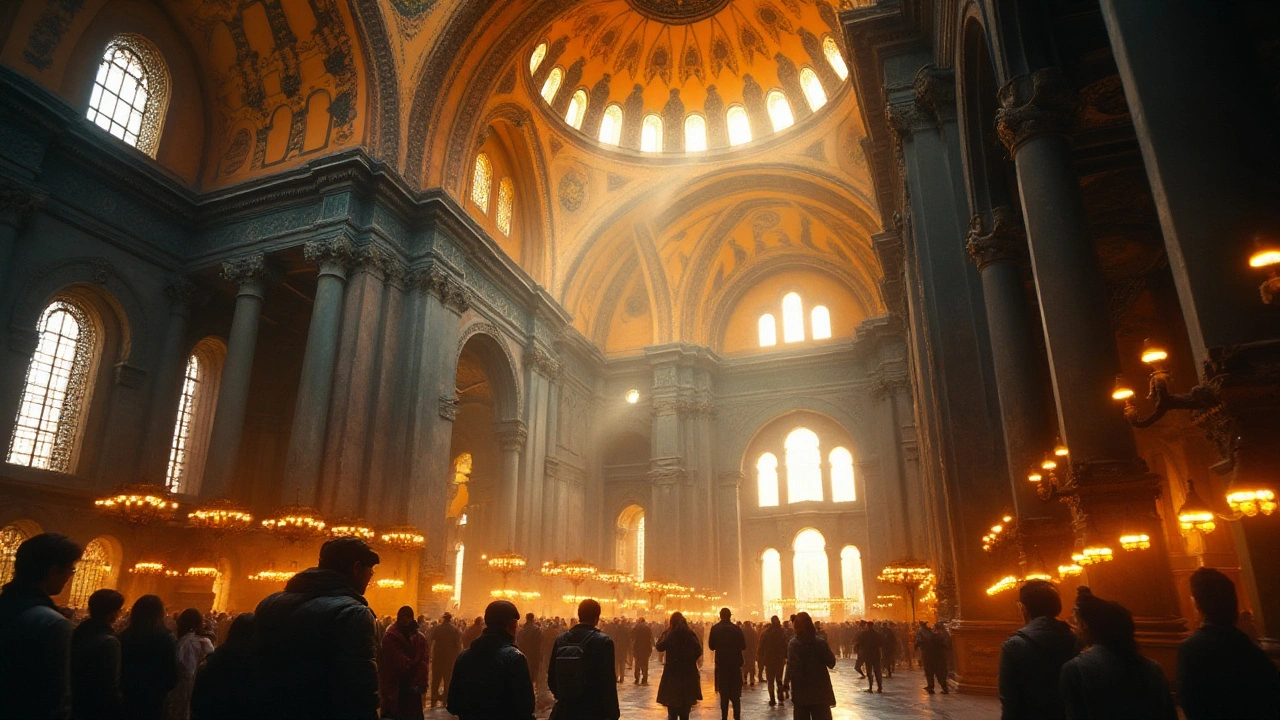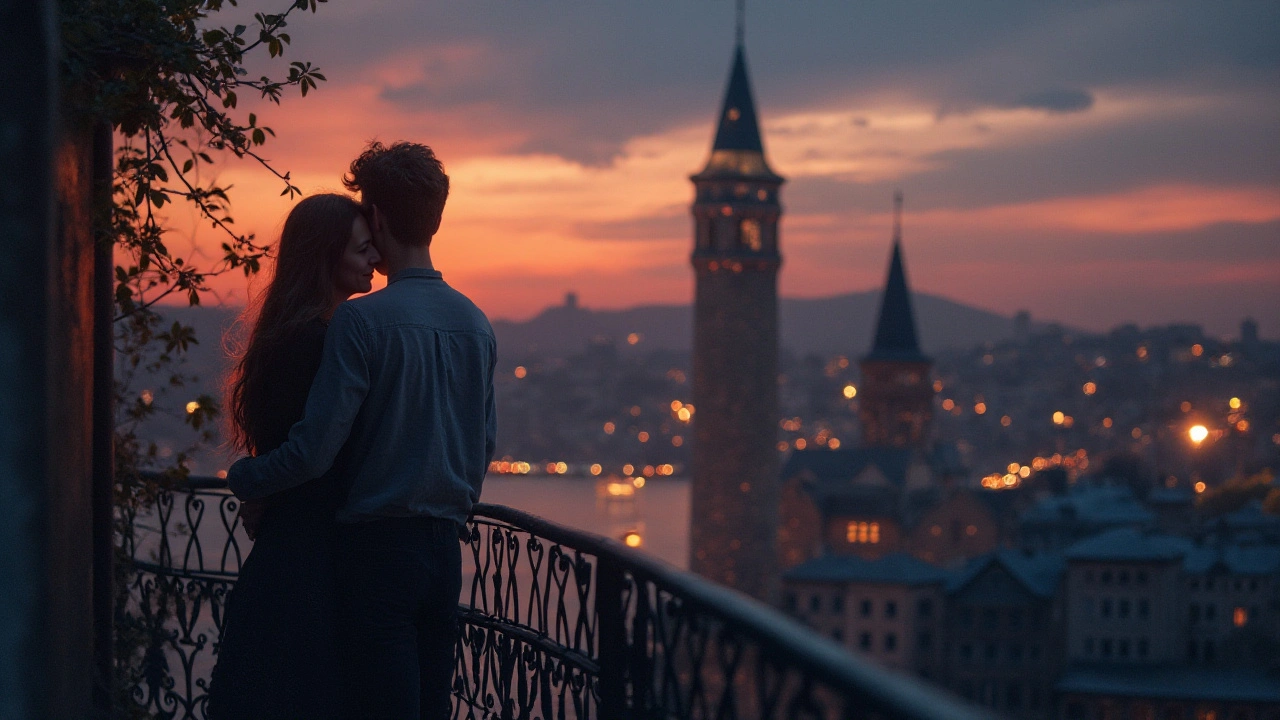Explore the Hidden Depths of Istanbul’s Basilica Cistern

Ever wondered what it's like to step into an underground wonder right in the heart of Istanbul? The Basilica Cistern is your ticket to such an experience. This hidden gem, buried beneath the bustling city, is rich with history and mystery. It's like entering another world where ancient architecture and the silence of the water create an otherworldly atmosphere.
Constructed in the 6th century during the reign of Byzantine Emperor Justinian I, the cistern was originally built to store water for the Great Palace. It's massive, with 336 columns lining the expansive chamber, creating a stunning visual that's perfect for those Instagram moments!
While you're there, keep an eye out for the infamous Medusa heads. No one can quite agree why they're there or what they're supposed to symbolize, but that's part of the fun, right? One of the heads is even placed upside down, sparking endless theories and myths.
Before you go, here are a few tips. Try to visit early in the morning or late afternoon to avoid the crowds. It can get a bit chilly underground, so you might want to bring a light jacket. And if you're wondering how to find this place, it's conveniently located near Hagia Sophia and the Blue Mosque—a perfect addition to your day's sightseeing itinerary.
- Key Highlights
- Historical Background
- Must-See Features
- Visitor Tips
- How to Get There
- Common Questions
Key Highlights
Strolling into the Basilica Cistern is like entering a grand subterranean cathedral. One of its standout features is its sheer size. Picture this: it's roughly 9,800 square meters with a capacity to store up to 100,000 tons of water. Not bad for a structure that's almost 1,500 years old, right?
Another highlight is the 336 columns that support this ancient marvel. Crafted from a hodgepodge of sources, each column tells its own story. Some even have intricate carvings, adding to the cistern's mysterious vibe. An interesting tidbit is that some columns sport the 'peacock eye' motif, a design thought to have protective properties.
Medusa Heads
The notorious Medusa heads are, without a doubt, the cistern's most famous residents. Located in the northeast corner, these two heads act as bases for two of the columns. One head is placed sideways and the other upside down, sparking endless debates among historians and enthusiasts alike.
Historical Context
Originally built to reserve water for the Istanbul palace, the cistern has centuries-worth of stories hidden in its stone walls. During its peak, it supplied water to the palace and some neighboring buildings, showcasing the advanced engineering skills of the Byzantine era.
For those who love stats, this might tickle your fancy:
| Feature | Detail |
|---|---|
| Height | 9 meters |
| Number of Columns | 336 |
| Water Capacity | 100,000 tons |
As you wander through, keep your eyes and ears open for the whisper of stories long past. Whether it's the cool, calming effect of the water or the echoing footsteps creating an eerie ambiance, there's something about the Basilica Cistern that captures the imagination.
Historical Background
Let's take a trip back to the 6th century. The Basilica Cistern was built during the reign of Byzantine Emperor Justinian I, who ruled from 527 to 565 AD. This massive underground water storage system was designed to supply water to the Great Palace and other vital buildings in the ancient city of Constantinople, now known as Istanbul.
Why a cistern, you ask? Well, in those days, securing a reliable water supply was a top priority. Constantinople faced water shortages and sieges, so an underground storage system was an ingenious solution. The cistern could hold approximately 80,000 cubic meters of water—enough to keep things flowing smoothly in times of drought or siege.
The architectural design of the Basilica Cistern truly is a work of art. Imagine a vast cavern supported by 336 marble columns, each standing about 9 meters high. These columns were salvaged from older structures, which is why you'll notice a mix of styles. Fun fact: some even date back to pre-Christian times!
Medusa Mysteries
Now, onto one of the most intriguing mysteries of the Basilica Cistern—the Medusa heads. Found at the base of two columns, these stone carvings have boggled historians and visitors alike. One head is placed on its side, while the other is upside down. There's no definitive answer on why they're there or who put them in such strange positions. Some say it's to ward off bad luck, while others think they simply fit better that way.
This cistern remained hidden for centuries until it was rediscovered in 1545 by Petrus Gyllius, a French scholar exploring Byzantine ruins. Today, it's not just a historical site but also a popular location for films and events, attracting thousands of visitors eager to soak in its eerie beauty.
Fancy a little comparison? Here's a quick look at the Basilica Cistern vs another famous cistern, the Binbirdirek Cistern, both in Istanbul:
| Attribute | Basilica Cistern | Binbirdirek Cistern |
|---|---|---|
| Columns | 336 | 224 |
| Storage Capacity | 80,000 m³ | 60,000 m³ |
| Build Date | 6th Century | 4th Century |
Must-See Features
When you're exploring the Basilica Cistern, there are a few standout features you absolutely cannot miss. Let’s dive deeper into these marvels.
Medusa Heads
The Medusa heads are probably the most talked-about feature of the cistern. Tucked away at the bases of two columns, these ancient stones attract endless curiosity. One head is upside down, and the other is sideways. While nobody knows the true story behind them, it's widely believed they were repurposed from earlier Roman sites. Catching a sight of these is like uncovering a slice of history shrouded in mystery.
The Columns
The cistern boasts an impressive 336 marble columns, each about 9 meters tall, arranged in 12 rows. Picture this: a forest of columns stretching as far as the eye can see. The ambiance here is nothing short of magical, with the dim lighting reflecting off the water below. Don't rush—take your time to admire the craftsmanship and design etched on these ancient pillars.
Hen's Eye Column
Among these columns stands the so-called Hen's Eye, or weeping column. It's distinguished by its teardrop-shaped embossments, which appear to be crying. This feature is perhaps a nod to the slaves who lost their lives constructing the cistern, adding an emotional layer to your visit. Look closely to see water dripping from its surface—it's a hauntingly beautiful sight.
Limited Exhibition
Every once in a while, the cistern hosts temporary art installations or exhibitions. These events offer a contemporary take on this historical space, so it's worth checking the schedule if you're in town. Your visit might just coincide with a unique artistic experience you wouldn’t find anywhere else underground!
Lighting and Atmosphere
One of the most breathtaking aspects of the Basilica Cistern is the magical play of light on the water. Softly illuminated pathways and spotlights make the place feel like a scene from a fantasy film. Visit in the late afternoon for the best ambiance when fewer visitors are around, allowing you to truly soak in the silence and mystery of the place.
This hidden gem of Istanbul offers more than just history; it’s an encounter with the past that’s both humbling and mesmerizing. Be sure to snap plenty of photos and carry these memories with you long after you’ve left.

Visitor Tips
Planning a visit to the Basilica Cistern? Here are some handy tips that'll make your experience seamless and enjoyable.
Best Time to Visit
To avoid the rush, try to plan your visit early in the morning or later in the afternoon. The cistern can get quite busy, especially during peak tourist seasons, which makes it challenging to fully appreciate its serene atmosphere.
What to Wear
It may be warmer above ground, but don’t let that fool you. The underground Istanbul environment can be surprisingly chilly, so it's a good idea to bring a light jacket. Additionally, the floor can be a bit damp from the water, so wearing non-slip shoes is a wise choice.
Photography
You’ll definitely want to capture the beauty of the Istanbul Cistern, but remember that flash photography is generally discouraged to preserve the artifacts’ condition and maintain the ambiance. Most areas are well-lit, so you should still get some fantastic shots without a flash.
Getting There
Finding the cistern is straightforward as it's situated close to major landmarks like Hagia Sophia and the Blue Mosque. It's ideal to combine these attractions into a single day's itinerary for convenience.
Tickets and Tours
- Check online for ticket prices and availability before you go. This helps avoid waiting in lines, especially during busy seasons.
- Consider guided tours for a more in-depth understanding of the Basilica Cistern's history. Guides often share fascinating stories and facts that you might otherwise miss.
Avoiding Crowds
Besides timing your visit, another way to dodge the crowds is to come on weekdays if possible. Weekends and holidays can see a spike in visitors, both locals and tourists.
Nearby Amenities
Even though you'll likely spend only an hour or so at the cistern, knowing nearby amenities can be handy. There are plenty of cafes and restaurants nearby where you can grab a bite or a coffee afterward. Istanbul is full of surprises just around the corner!
How to Get There
Finding your way to the Basilica Cistern in Istanbul is pretty straightforward once you know the ropes. Nestled right in the Sultanahmet neighborhood, it’s super close to other famous spots like the Blue Mosque and Hagia Sophia. So, if you’re sightseeing, it’s easy to include in your itinerary.
By Public Transport
If you’re exploring using public transport, the easiest way is by tram. Jump on the T1 Tram Line and hop off at the Sultanahmet stop. From there, it’s just a 5-minute walk. Just follow the signs, and you'll soon find yourself at the entrance.
By Taxi or Ride-Share
Prefer a quicker ride? Taxis and ride-shares are always an option in Istanbul. Just put “Basilica Cistern” into your app, and your driver will take care of the rest. It’s a pretty popular destination, so even if the driver doesn’t speak much English, they’ll know where you’re headed.
Walking Directions
Already in the area? Walking is a great choice in Sultanahmet. If you’re at the Blue Mosque, face away from it and head down the main road, Divan Yolu Caddesi. Keep walking straight, and in about 10 minutes, you’ll find the entrance to the Istanbul Cistern on your left. Enjoy the short stroll through this historic district!
Some Final Tips
- Check the Istanbul Cistern opening times before you head out. They can change depending on the season or public holidays.
- Consider buying a museum pass if you plan to visit multiple attractions. It can save you both time and money!
- If you’re coming by car, parking can be a hassle in Sultanahmet. Try to use public transport or park in a designated area and walk a bit.
Common Questions about the Basilica Cistern
Wondering what you should know before visiting the Basilica Cistern? Let's dive into some frequently asked questions:
What is the best time to visit?
The Basilica Cistern sees fewer visitors early in the morning or late in the afternoon. These times offer the most peaceful experience, allowing you to soak in the atmosphere without the crowd.
Is there an entrance fee?
Yes, there is a small entrance fee. As of the last update, it’s around 100 Turkish Lira for international visitors. Prices might change, so it's a good idea to check ahead.
How long should I plan for the visit?
Most visitors spend about 30 to 45 minutes exploring. If you're into photography, you might want to stay a bit longer to capture those perfect shots.
Are guided tours available?
While you can explore on your own, guided tours are available and can add some intriguing historical context to your visit. Guides often share fascinating stories you might miss out on otherwise.
Can I take photos inside?
Absolutely! Photography is allowed, and you'll find plenty of Instagram-worthy spots. Just remember to be considerate of other visitors while snapping your shots.
How is accessibility for visitors with mobility challenges?
Unfortunately, the Basilica Cistern might be challenging for visitors with mobility issues due to its stairs and occasionally uneven flooring. It's a good idea to check current accessibility options before your visit.
Is there anything nearby worth visiting?
Definitely! The Basilica Cistern is a stone’s throw away from other major attractions like the Hagia Sophia and the Blue Mosque. It's an excellent addition to any day of sightseeing around Istanbul.
If you have any more questions, feel free to ask staff at the site. They're usually helpful and well-informed about this captivating Istanbul attraction.

